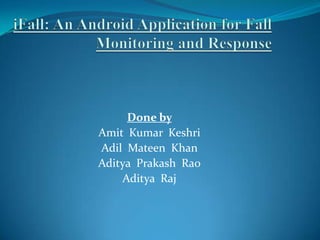I fall ppt
- 1. Done by Amit Kumar Keshri Adil Mateen Khan Aditya Prakash Rao Aditya Raj
- 2. What is ANDROID? A mobile OS initially developed by Android Inc. based upon a modified version of linux. Consists of Java apps running on Java based OO application framework. Developed by Open Handset Alliance in partnership with Google. Versions of android: a) Android 1.5 b) Android 1.6 c) Android 2.1 d) Android 2.2 (Android FROYO)- most used version.
- 3. We propose a low priced system that is well suited to all the requirements by using existing mainstream technologies that are reliable. Our approach is to use fasting growing device like programmable cellular phone. Reasons for using android cell phone: ï§ Cost reduction. ï§ Integrated hardware. ï§ Cell phones are discrete than a dedicated monitor device ï§ To limit false positives we implement several fall detection algorithms and two stages of communication
- 4. Background User response service for detection by detecting fall using alerting user to accelerometer respond Timer to wait for Reset ifall If the user responds user response application If the user doesnât respond Send emergency message to the care Send message to authority social contacts set by the user. Wait for people to respond
- 5. ï§iFall runs a inconspicuously as possible while using limited resources. ï§When the algorithm suspects a fall the service will wake up and interrupt the user. ï§If the user responds, the previous activity is restored and iFall will sleep again. ï§By only waking up the activity when a fall is suspected or requested by the user, we allow application to run on top of iFall while we minimize our memory consumption and user interaction.
- 6. ï§Activities of Daily Living(ADL) are normal activities such as walking and standing. ï§The forces exerted during ADL are usually different than the forces during a fall. ï§A fall typically starts with a short free fall period. ï§This causes the accelerationâs amplitude to drop significantly below the 1G threshold.
- 7. ï§Reliability and reduced number of false positives mean greater adoption by emergency services. ï§Our system provides a viable solution to increase fall detection among people. ï§Using existing, mass marketed technologies will limit cost making it available to the majority of the public.
- 8. ï§Our system provides a viable solution to increase fall detection among people. Using existing, mass marketed technologies will limit cost making it available to the majority of the public. ï§Implementing proven fall detection algorithms makes the system highly reliable. Reliability and reduced number of false positives mean greater adoption by emergency services. ï§The importance of the cell phone in everyday life decreases the chances of being forgotten. Everyday interaction with the phone makes the interface more familiar to the user.
- 9. ï§A cell phone is also less intrusive than dedicated devices ï§ The familiar interface, non-intrusiveness, and affordability leads to less rejection from users. ï§By combining cheap hardware and open source software, we hope to provide a realistic answer to reducing the long-lie period for the elderly.










